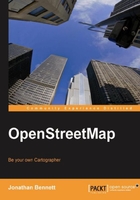
The slippy map is the name used to mean the interactive sliding map viewer used on the front page of openstreetmap.org. It uses an open source JavaScript library called OpenLayers, and sets of map tiles that are assembled to form a continuous, movable image. Tiles for different zoom levels show different amounts of detail, depending on the rendering rules used. Apart from being the usual way of showing the map, it's also a tool for mappers to examine the data behind the map.
You can move the map around using the controls in the top left-hand corner of the map, and zoom in and out using the slider. You can also drag the map around with your mouse or pointing device, or zoom in and out using a mouse wheel, if you have one. You can zoom in on a particular area by holding down the Shift key and dragging a rectangle over the area you want to see. Double-clicking on the map will re-center the view and zoom in one level.
On the right-hand side of the map, you'll see a plus sign against a blue background; this is the layer chooser. Click this to expand the box, and you'll see the list of available base layers and overlays. A base layer is the underlying map shown, while an overlay adds detail to whichever base layer you've chosen, and may include an interactive element. You can use any overlay with any base layer, but you'll only be able to interact with the top overlay.

The first two base layers are named after the programs used to render them—Mapnik and Osmarender. We'll cover how both of these programs work later in the book. These layers are designed to show the amount of detail that OpenStreetMap's data contains, but may not include everything in the database, either for the sake of clarity, or because a class of feature may not be in widespread use yet. In general, you should expect to find common features, such as roads, paths, buildings, waterways, points of interest, and landuse shading on these maps. These layers are continually updated, so changes to the database usually appear within a few minutes, depending on how many mappers are making changes and how many people are viewing the map at the time.
The Cycle map is an example of a specialist rendering of the data, and shows cycle networks overlaid on a map with contour lines. It was one of the first alternative renderings of OpenStreetMap data, and has its own site at http://www.opencyclemap.org/. The Cycle map layer is updated less often than the first two layers, generally once a week.
The final layer, called NoNames, is a maintenance tool for mappers, highlighting any streets in the database without a name, where one would normally be expected. The NoNames layer was created to help mappers see where streets had been added to the database by tracing aerial imagery, which doesn't provide the names of the streets. This is only a guide, and not every road highlighted in this layer will actually have a name. It's updated once a week, so any names you add to the data won't show up straight away.
There are two overlays on the slippy map; the maplint overlay and the data overlay . Maplint shows parts of the map that use undocumented tags or has suspected errors, while the data overlay allows you to see the actual data behind a feature on the map, including any tags attached, when it was last edited and by whom. We'll cover how to use both of these overlays in Chapter 5.
At the bottom right-hand corner of the map, there are two hyperlinks, labeled Permalink and Shortlink. Both of these give you a link to your current map view, so you can bookmark it or share it with others. The permalink includes the full co-ordinates of the location, while the shortlink uses a code, and is more compact but less readable. To copy either the permalink or the shortlink, right-click on the link and choose Copy Link Location or your browser's equivalent.